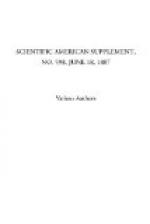As both surfaces of the lead are utilized, their weight is reduced to 51/2 kilos. A No. 10 therefore requires 55 kilos. of useful lead. It will be seen that to increase the thickness of the sheet of lead merely augments the duration of the accumulator, without affecting its capacity or its manner of charging and discharging. Nos. 1, 2, 3, and 4 may be placed in vessels of stoneware, glass, or ebonite, or in boxes of pitch pine, painted with three coats of gum lac and lined with sheet lead. Nos. 5 to 12 are only sent out in pitch pine boxes lined with lead. The box is supported on feet of porcelain of the shape of a mushroom. If a drop of water falls upon this foot, it cannot give a communication with the earth, since, falling upon the broad part of the mushroom, it will glide off without running along the foot, which serves as the stalk of the mushroom. A slip of glass is placed under each foot; the part which supports the mushroom is covered with an insulating varnish, which prevents the formation of climbing salts and preserves the screws from rust. A common layer of insulating varnish is applied under the head of the mushroom.
As regards the advantages of the Montaud accumulator we notice, first, its longevity. Dr. D’Arsonval points out that the accumulators of the Plante class have a great advantage over the Faure type as regards duration, and that the most striking quality of the Montaud accumulator is its longevity. The inventor has in his possession positive plates, five to six years old, completely peroxidized, though there remains in the interior a thin core of metallic lead sufficient to give passage to the current. The adhesion of the peroxide is such that to detach it, it must be beaten with a hammer upon an anvil. The next four points—i.e., the rapidity of charge; the yield, much greater than that of any other system in proportion to its surface; its small weight in comparison with its yield; and its capacity, which for an equal weight is greater than that of any other accumulator. In his experiments in September, 1885, Dr. D’Arsonval obtained with an accumulator of 2 square meters of surface:
Useful capacity 40
ampere hours.
Total 62
" "
Surface 2
square meters
Charge 10
amp. per sq. meter.
Discharge 20
" " "
Useful weight of lead 10
kilos.
Representing a total capacity of six ampere hours per kilo., and of a discharge of 5 amperes per kilo., or a total capacity of 81 ampere hours per square meter, and a useful capacity of 20 ampere hours per square meter. Subsequently the modification of the negative plate has greatly improved these figures, which will certainly become much more advantageous in future. The total capacity of an accumulator having exactly 13/4 meters of surface has become 87 ampere hours, which if referred to an accumulator of 2 square meters of surface, would give the following results:




